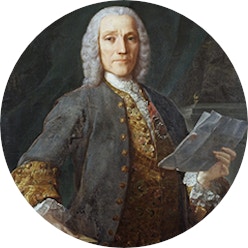
Domenico Scarlatti
October 26, 1685 - Naples — July 23, 1757 - Madrid
About
Scarlatti, the unique style of the sonata
A composer, a virtuoso harpsichordist, the greatest master of the sonata for harpsichord, Domenico Scarlatti really marked baroque music with the singular and virtuoso form of his music. From the musical education he received from his father, at this time director of the Royal Chapel of Naples, to the colours of Spanish folklore that influenced his musical production during the years he spent in Spain, Scarlatti developed a unique style of the sonata, that was different from the models set by Mozart, Haydn or Beethoven. In an instrumental sense, the "sona-tas" he composes have the aim to make the instrument resonate. Scarlatti let to posterity a collection that counts more than 550 sonatas for keyboard, that are composed according to a formal scheme quiet simple. Nevertheless the intentions and the themes he includes in it are very rich and varied, and let a great place to experimentation in performing them. The sonatas also have a educational aim, they become real "essercizi" (exercises for harpsichord).
Scarlatti, the music teacher
As a music teacher, Scarlatti is appointed in great european courts of the times. Aged 16, he is appointed clavicembalista da camera, i.e. the composer and organist of the Royal Chapel of Naples. He will be afterwards appointed in prestigious positions in great musical centers across Italy. He will be firstly Master of the Chapel of the queen Maria Casimira from Poland in Rome, then at St. Peter's Basilica. After that, he will devote time to sacred music when he begins to serve Jean 5th, then under the service of Maria Barbara de Braganza in Seville, Madrid and Aranjuez.Scarlatti and his contemporaries at the heart of the baroque period
In addition to be contemporary to Bach and Handel that were born the same year, Scarlatti meets Handel around 1709, and they become friends. Both incredible harpsichordists, they distinguished in particular at the occasion of a musical spar, Handel playing organ, Scarlatti playing harpsichord. Through his unique style that oversteps the formal limits of the sonata and that has a certain virtuosity, Scarlatti nevertheless will distinguish from the two other masters of the Baroque period. Scarlatti also composed beautiful religious works. When he dies in 1757, Scarlatti leaves a monumental work, that has been recognized across Europe. In the Music History he is considered one of the most important masters of harpsichord.

